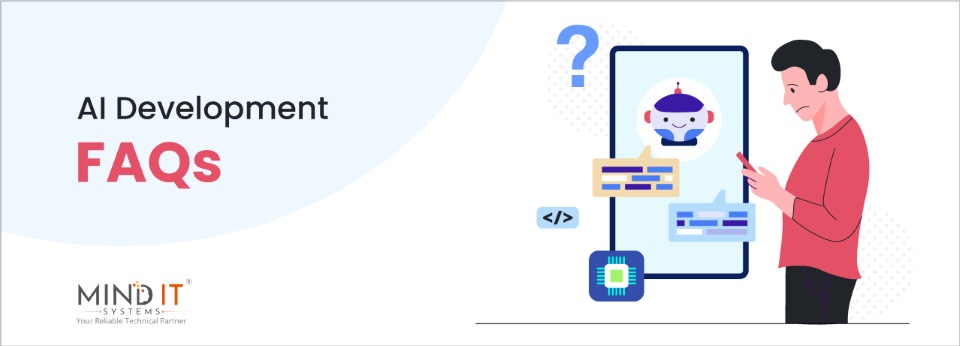
11
Jul
AI Development FAQ
in Blog
Comments
Frequently Asked Questions About AI Development
Artificial Intelligence isn’t just reshaping the future—it’s transforming the present. From intelligent chatbots to predictive analytics, AI is powering smarter decisions and seamless user experiences across industries. But with innovation comes complexity, and it’s natural to have questions. This FAQ page is your go-to guide for everything you need to know about AI development—whether you’re exploring its possibilities, planning your next AI-powered project, or simply curious about how it all works.
Ans: AI development is the process of designing intelligent systems that mimic human thinking by using data, algorithms, and machine learning. These systems automate tasks, make predictions, and help businesses enhance efficiency, decision-making, and customer engagement.
Ans: AI is important because it automates repetitive tasks, speeds up data analysis, enhances decision-making, reduces costs, and improves customer experiences. It drives innovation and helps businesses stay competitive across various industries by leveraging intelligent technologies.
Ans: AI is the umbrella term for smart machines. Machine learning (ML) is a subset where systems learn from data. Deep learning is an advanced ML technique using neural networks to recognize patterns in complex data like images and text.
Ans: AI developers create tailored solutions that automate processes, analyze data, personalize user experiences, and generate insights. Their work boosts operational efficiency, drives digital transformation, and helps businesses become more scalable and data-driven in decision-making.
Ans: If your business handles large volumes of data, faces repetitive tasks, or needs faster, data-based decisions, AI can help improve performance, reduce errors, cut costs, and provide a strategic competitive advantage in your industry.
Ans: Common AI use cases include chatbots for customer service, fraud detection, image and speech recognition, recommendation engines, predictive analytics, automated content generation, and intelligent automation across sales, marketing, finance, and operations.
Ans: AI developers should have expertise in Python, machine learning libraries like TensorFlow or PyTorch, data science, statistics, algorithm design, and experience with model training, evaluation, deployment, and real-world problem-solving using intelligent systems.
Ans: Hire AI developers through trusted staffing agencies, AI consulting firms, or staff augmentation partners that offer pre-vetted professionals with domain experience, ensuring the right fit for your project’s technical and strategic requirements.
Ans: Pre-vetted AI developers are professionals who’ve been evaluated for technical proficiency, communication, and project readiness. They help reduce hiring time, ensure quality, and are better aligned with project needs from day one.
Ans: AI staff augmentation is a hiring approach where businesses temporarily extend their teams by adding external AI experts. This allows rapid scaling, flexibility, reduced recruitment time, and access to specialized skills without long-term commitments.
Ans: AI development costs depend on scope, complexity, and duration. Small projects may start at $10,000, while enterprise-level solutions can exceed $300,000, especially if they involve custom models, integrations, and extensive testing phases.
Ans: Developing an AI solution typically takes 3 to 6 months, depending on the problem complexity, data availability, model design, testing, and deployment. Timelines may vary based on business goals, technical challenges, and team expertise.
Ans: AI development includes defining the problem, collecting and preparing data, building and training models, testing for accuracy, deploying the solution, and continuously monitoring and refining it to improve performance and adapt to new data.
Ans: Yes, small businesses can afford AI by starting with smaller projects, using cloud-based AI tools, or partnering with vendors offering flexible engagement models like outsourcing or staff augmentation, which lowers costs and resource overhead.
Ans: AI development risks include biased training data, overfitting, lack of model transparency, security vulnerabilities, and project failure due to vague goals or poor data quality. These can be mitigated through planning, validation, and expert oversight.
Ans: Preparing data for AI involves cleaning, formatting, labeling, and organizing it into training and test datasets. This includes removing duplicates, normalizing values, ensuring consistency, and making sure the data aligns with business objectives and AI goals.
Ans: AI can integrate with existing systems using APIs, cloud-based tools, or custom-built interfaces. Integration allows AI models to access and process real-time data, deliver insights, and automate tasks across your existing business infrastructure seamlessly.
Ans: Ensure success by defining measurable goals, tracking performance metrics, testing the model regularly, retraining it with new data, and working with experienced AI developers who align the solution with your business outcomes and evolving needs.
Ans: Building in-house offers control and long-term value, while outsourcing is faster and more cost-effective. A hybrid model combining internal oversight with external expertise can offer scalability, quality, and faster results for most businesses.
Ans: Mind IT® provides experienced, pre-vetted AI developers with deep ML expertise, fast onboarding, and flexible engagement models. Their tailored approach helps businesses design scalable AI solutions aligned with specific goals, timelines, and budgets.
Ans: Data annotation is the process of labeling datasets—text, images, or video—to train machine learning models. It’s crucial in supervised learning, enabling models to understand input context, improve accuracy, and deliver relevant predictions or outcomes.
Ans: While not required, cloud platforms like AWS, Azure, or Google Cloud provide scalable computing power, prebuilt AI services, and automation tools that accelerate development, simplify deployment, and reduce infrastructure costs for AI projects.
Ans: They ensure accuracy by using clean, diverse data, applying cross-validation, and tracking key metrics like precision and recall. Continuous model training, monitoring, and feedback loops also help minimize errors and improve predictive performance.
Ans: Yes, AI models can be customized for small businesses by focusing on specific tasks, leveraging pre-trained models, or using no-code/low-code tools. This allows affordable, scalable solutions that meet business needs without heavy infrastructure investment.
Share this post

